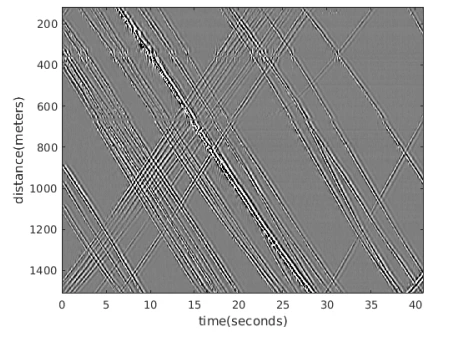Fotech Solutions
 Figure 1: DAS response showing multiple vehicles travelling along a fibre optic cable
Figure 1: DAS response showing multiple vehicles travelling along a fibre optic cableTraffic monitoring with distributed acoustic sensing
Industry Mentor: Matt McDonald, Chief Technology Officer, Fotech Solutions
Problem Description
Consider the application of distributed acoustic sensing (DAS) system monitoring to a fibre optic cable deployed along an active roadway. Traffic on the roadway causes mechanical deformation of the ground which strain the fibre optic cable, causing phase shift in the backscattered light measured by the DAS system. Figure 1 shows the system response as traffic moves along the fibre optic cable.
Analysing a subset of the data in window in space-time allows individual vehicles to be recognized. Transforming this data into the time-slowness ($\tau−p$) domain using a Radon transform then admits a representation suitable for counting the number of vehicles present in the frame and identifying individual velocities using standard peak-detection methods. Figure 2 shows a subset of data with four vehicles travelling in the positive direction at different velocities and the Radon transform of the data showing four peaks isolated in the ($\tau − p$) domain, each labelled with its associated velocity.

The proposed problem, is to develop a detection and tracking method capable of identifying individual vehicles and reporting their position and velocity as they move along the road/fibre. Furthermore, once the position and velocity is determined, various metrics for traffic flow could be determined, allowing for prediction and optimization of traffic congestion.